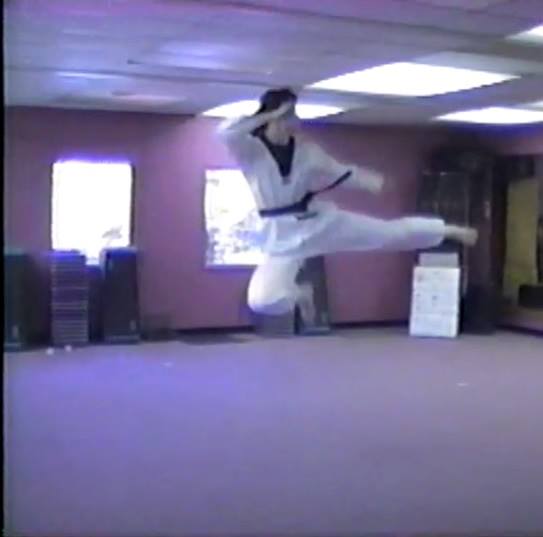From the Scrapbook
These video clips were taken in 1991. Hard to believe that 20 many years have passed! I was second degree black at the time.
It's a dangerous thing for a woman to think she is as strong as a man. No matter who the man is, and no matter who the woman is, chances are, the man is stronger. To demonstrate how strong men are compared to women, my friend Berry and I would demonstrate arm wrestling to show women how unlikely it is that a woman could ever overpower a man by strength alone.
We would start with my arm against his arm; then I would try with both my arms against his one arm (pictured below). We would end up with me bracing both feet against him and using both arms to try to pin his arm, and he would still win at arm wrestling. It used to make for a funny introduction to a serious demonstration about women and self defense. Here are a couple video stills of Berry effortlessly defeating me.




|
From ten years ago, here is a very grainy shot of a man I admire very much, Bill Rogers. ("Mr. Roberts" in The Tae Kwon Do Memoirs. He is now a fifth degree black belt in tae kwon do. Technically, this makes him a master, but following the tradition of our school, he does not wear the red stripe of master, nor is he addressed as anything more grand than "Mr. Rogers" (This in spite of the fact that he has an earned doctorate and has served on the National Council for the Humanities.) In this picture, he has just fully extended on a side kick and is retracting his foot.
|
|
Here is Bill Rogers again, executing a jump side kick, about a split second before full extension. In spite of being six feet, two inches tall, he is quite aerial in this shot. |

|
|
My own youth (31) finally encountered in-depth instruction during this period of my life (1991). Following Berry's example, I visited my friend the heavy bag every other day. In this series of shots, I am executing a back kick, meaning I kicked from the back leg and turned "backward" to take full advantage of the hip's inertia. The back kick has the disadvantage of a slight awkwardness and a moment's blindness from the target, but it offers much greater power than a forward-thrown side kick. You can see that I (dressed in a padded vest for training purposes)strike the bag in this shot.
|

|

|
This is the kick at absolute full extension, and you see that I am starting to crumple in my posture, which is not perfectly correct form. Maintaining proper posture is a skill I am now working on.
|
|
In this final shot, you see that I have lost correct posture rather badly. I would not show this picture of myself making such a huge blunder in correct form, except--goodness gracious me!---look at that bag. It's flying away. I suppose if I could always kick with that much impact, it wouldn't matter what I did with my posture after hitting the target.
|

|

|
It amazes my friends to find out that I hate sparring. Quite frankly, I do not want to hit my martial arts friends, and I do not want to get hit. When I was younger, I was more aggressive because I never thought I could hurt anybody, But now that I know differently, I just don't like sparring.
However, here is a series of clips from one fight, just to show that I can sometimes fight by the right principles if I have to. In the first picture, I have my back to the camera. I pick up the left leg as though I am about to short side kick into my opponent.
|
|
I use the momentum to actually slide closer, hopefully gaining a few inches of terrain that he does not adjust to. Then I drop the feinting leg and start the turn.
|

|

|
As far as I am concerned, I just want to keep a male opponent out from a striking zone. I almost never fight "to win." As you see here, I covered some distance unexpectedly, and so my opponent is simply ducking rather than trying to come in further into my "zone." For a person who does not really want to hit her opponent, this is ideal, and I consider the technique a success at this point.
|
|
As you see in this final shot, I am able to get the back kick off smoothly. I would consider the feint+back kick combo to be a success against this opponent, but a more aggressive partner might have stepped around it. As I prepare for fifth degree over the next five years, I will have to develop more assertiveness in my fighting skills until I am able to control an opponent beyond just making him back up.
|

|

|
And here is more of the same: throwing a quick jump kick to keep the guy out so we don't really have to fight.
|
Training for Fourth Degree
In this picture, I am actually coming down from the kick. The camera shutter got it about half a second too late. The perspective is a little flat, but I've already kicked the bag and am landing. But I like this picture because you can see that the bag is tipping over. And you can also see how much I like jumping and kicking.
|
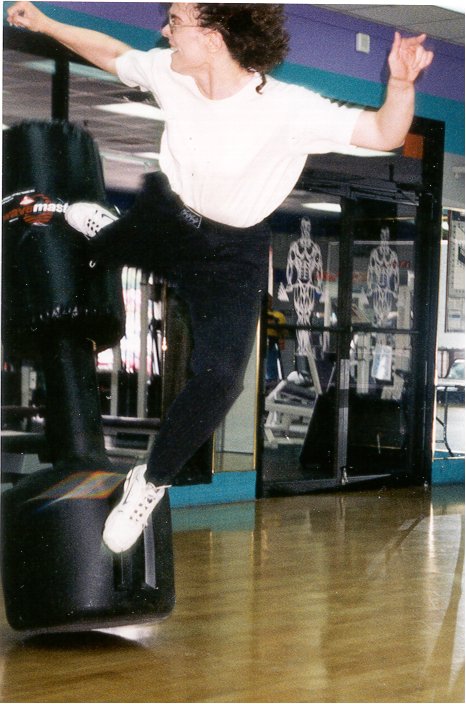
|
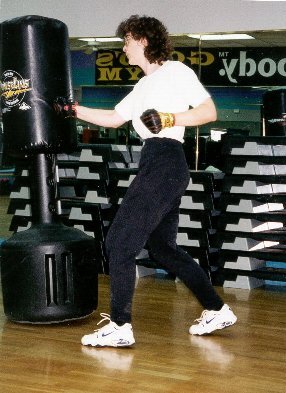
|
If you look closely, you'll see that the platform of the bag is rocking up off the floor. I was the only person who could do that at Gold's Gym. The bag is designed to absorb a blow into its padded, pillowy top section, and the semi-flexible "stem" is also designed to give so that the bag does not rock or move. Most other people who practiced on the bags could push them back with punches or kicks, but I could get the platform to rock up. I worked on this when I was developing hand speed to break concrete. To get such an absorbent target to rock up, you have to hit it fast and yet very solid. The only way to do this is to relax everything and punch from the hip with the knees slightly bent. At the last instant, you exhale and lock all the muscles and then immediately release. The camera got me at the exact right moment. I spent hours and hours on that bag, about two hours per session, three to five sessions per week, for about five months.
Even so, I have not yet gotten consistent with being able to break concrete, though I have broken single concrete patio blocks a couple times. The difference, of course, is that I am unafraid to hit the bag, but when I look down at a concrete tile, part of me still fears it, and so I do not attain my best speed, except in rare days when I feel "on". The final confrontation in the martial arts is always against the self!
|
Looks like I rammed my fingers in an electrical socket. Actually, I was landing from a kick and turning to jump again, and the camera caught me with my hair on end, which I think is funny, and sort of interesting. You never think about what your hair does while you are kicking.
|

|
Testing for Fourth Degree
I trained faithfully for fourth degree black for three and a half years, and then a couple months before the test, I evidenced early signs of a form of cancer called Paget's Disease. After several exams that led to a biopsy, I was finally pronounced cancer-free. But the experience left me under-trained in some of the finer points I had wanted to work on right at the end before the test. And I committed an incredible blunder in overtraining so severely that I came to the test with my right hip joint inflamed, and I was physically exhausted. It was a test of mental resolve more than anything else.
|
|
With my right hip joint inflamed, I came to the training hall early, and in the half-light, I tried to work the right leg to see how much I could do with it. Actually, as I worked and prayed in the silence, a great peace came over me. I think that hour spent alone before the test was one of the richest and yet most quiet hours of my life. I did not have cancer, and I would soon be in fellowship with my Christian black belt brothers and sisters: my favorite people. They would hope for the best in me and yet be honest and instructive.
|
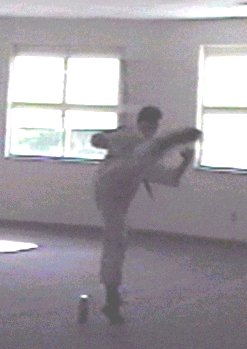
|
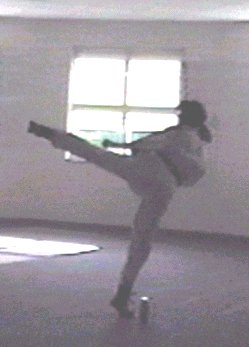
|
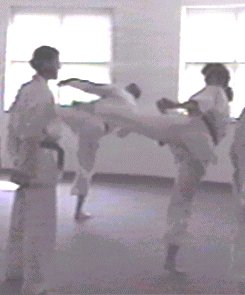
|
The leg held up better than I had expected. Here we are, with the training hall open, during the drill session. All the people who had come were either there to serve as partners, opponents, or else as evaluators. The man I am working with, Bruce, is a very dedicated martial artist who has developed many fine boxing skills. He is one of the kindest men I know. I felt lucky to get him as a partner. He expected me to do my best, but he certainly did not do anything to sabatoge me, and he knew how to let me show my skills to their best.
|
|
The next four video stills show a very formal, classical drill called one-step sparring. My opponent simply executes a straight-line attack (a stepping punch). This is as basic as it gets, yet all the way to the highest levels of black belt, we are required to test on these skills. On the one hand, I would not fight like this on the street to defend myself, as it is too stilted. One the other hand, classical drills like this teach you to sidestep instantly and get out of the way (or better yet, throw out a kick to interfere with the attacker's motion), so it is probably useful as a tool. In the first two pictures, I sidestep and kick, then spin, grab his collar from the back, and kick his front leg out from under him.
|
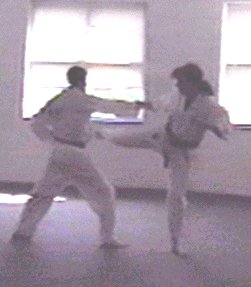
|
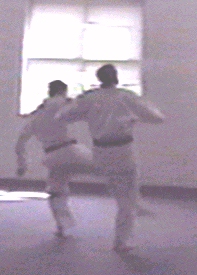
|
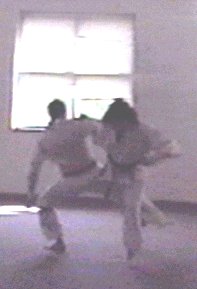
|
The still on the left shows a more conventional footsweep, executed after a series of elbow strikes.
The still on the right depicts a side kick, our Number One kick. Great for power and speed.
|
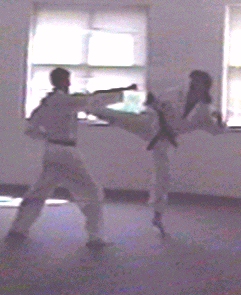
|
I dislike classical knife defenses because I doubt I would use the classical methods to disarm an opponent. Jeet Kune Do and the Filipino martial arts offer much more practical methods for getting a knife away from an opponent. However, there is no doubt that the classical "key lock" which I am executing as Bruce tries to stab me with a fake knife, is a vital hold for any martial artist to know. It's a way to get an opponent's arm to bend in its natural motion before it is turned against the shoulder blade's natural positioning, so even a woman can successfully apply it, even if just for a moment. That should be long enough to execute a throw.
|
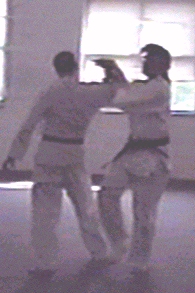
|
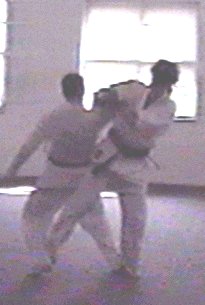
|
Breaking two boards with a back kick. A fairly lackluster kick, really. I was exhausted, and I was thankful that the boards broke. It was hailed as a good test, but I was thankful that it was over. I spent the next six weeks letting my right leg and hip heal.
|
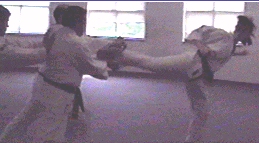
|
From the demonstration at Chicago TARDIS, 2001

|
The The Martial Arts in Time and Space demo was meant to illustrate some of the fallacies of martial arts as they are depicted in TV, and to provide some usuable step-by-step self defense techniques that amateur video makers could use. About 25 people showed up, which is a lot for a fan panel (and we were opposite an autograph session of the UNIT men). But most of the people who came just wanted to see some martial arts.
In this shot, I am illustrating how a woman (or lighter person) moves off the center line as she strikes. My patient opponent is standing still much more than a real villain would.
|
This is a badly thrown kick, an instep kick. It's one of the most useless kicks to throw, and it shows up all the time in martial arts on television. When I was explaining that it's useless in real life, I threw the kick to demonstrate, and everybody snapped pictures. I explained that this was NOT one of the good kicks, but people in the audience said they just wanted to take pictures of kicks.
The key to these fan panels is just to go with the flow, so I said okay.
|

|

|
How to slip a punch. Again, my villain is giving me a lot of slack. But the purpose of the demo was to show people how to set up a fight scene. John punches, and I "slip" the punch so that I can come back and counter attack.
|
|
How to stick and trap. As long as the person defending doesn't try to wrestle with the arms of the stronger opponent, she can push the atacker's arms across his body to momentarily jam him (or "trap" him)/ This gives the smaller, lighter, weaker person a chance to get in a strike.
|

|

|
How to set up a fight scene. The key is to have both people rehearse the steps slowly so that they can get the motion down. They also need to practice which way to fall back and move around.
|
|

|
Adding the drama. Now John looks like he's getting pretty beat up. But you can see that I start to laugh as he "chews the scenery." The audience appreciated John's enthusiasm. He was great.
|

|
The self defense sequences. Up until this part, everything was about how to set up the motion, what kicks would actually work, and how fighters actually move. This section was meant to show step by step methods of getting out of some typical attacks. The first, and most typical, is the choke.
|
|
Escape and counter from a side-choke on the ground. This is the same technique depicted in the old TKD textbook by Richard Chun. It's also used by grapplers. The woman jams her near knee into the attacker's chest to stop him from bearing down on her. Then she uses her hips to swing her other leg high and scissor him across his throat.
|

|

|
The Villain and Heroine. I warn John that if he keeps smiling while having his picture taken, he will lose his bad guy image. But John does not seem all that concerned. Like most men who play villains, he actually has a heart of gold.
|
Older, Wiser, Fatter, and Slower

|
On my 53rd birthday, after 12 years out of physical martial arts training, I retuned to Taekwon Do, a shadow of my former self. A big fat shadow, with arthritis. |

|
One more "Then" and "Now" photo set. I used to rag on myself for not being better than I was. Now when I look at the old photos I think I was tremendous. |

|
The final "Then" and "Now" photo set. Then again, how many women at 53 can even do what I am doing in the shot on the right? |

|
Back kick, fat and arthritic style. |

|
This shows the weakness in my hip muscles. The kick will not be high because I am not picking up the knee very high, but at this point it was the best I could do. |

|
The form is weak, bt there is strength in the kick. |


























